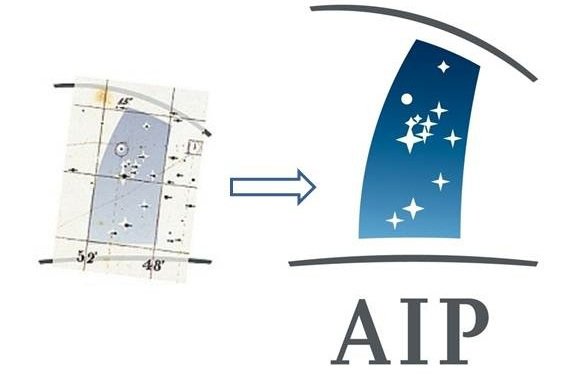The history behind the AIP logo
The logo of the AIP symbolises an observer's view from the interior of an astrophysical telescope’s dome, looking through the dome’s opening into the starry night sky.

The stellar constellation that led to the discovery of Neptune inspired the new AIP logo.
In search of a new planet
In the morning of 23 September 1846, Johann Gottfried Galle, an assistant at the Berlin Observatory, received a letter from Jean Joseph Urbain Le Verrier, an astronomer at École Polytechnique in Paris. Le Verrier was working on the "problem of Uranus", trying to understand why Uranus was not observed at the location on sky where it was predicted to be. The solution to the problem was expected to be an as-yet unseen planet, which was gravitationally perturbing the orbit of Uranus. The mathematical problem Le Verrier was attempting to solve was unprecedented, and yet he was confident he determined the location of the planet, and, therefore, asked Galle to search for it at a given region of the sky.
Galle proceeded to ask the director of the Berlin Observatory, Johann Franz Encke, for the permission to use their superb Fraunhofer telescope to honour Le Verrier’s request. Encke, who was celebrating his 55th birthday that day, permitted the use of the telescope. Galle’s and Encke’s conversation was overheard by Heinrich Louis d’Arrest, a student that was working at the observatory, who excitedly asked Galle for the permission to join the observations. Galle allowed d’Arrest to join, and even asked him to prepare what was necessary for the observations.
Galle and d’Arrest first followed the instructions of Le Verrier to look for the planet as a well-defined disk on the sky, but they were not successful. They also tried to use a standard sky chart of the region where the planet was predicted to be, but they quickly realised that the chart was missing a number of stars and was not useful for the search. d’Arrest then remembered that there should be a new chart of the same region, recently completed for the mapping project of the Berlin Academy of Sciences. Galle and d’Arrest went to an antechamber of the director’s office and found the chart, Hora XXI, completed by Carl Bremiker. This chart was waiting for another map from the series to be then distributed to all major observatories worldwide. As it happened, however, on that day only Berlin Observatory had it.

Excerpt from the Hora XXI sky chart of the Berlin Science Academy completed by Carl Bremiker. The work on the chart started in 1826, but was completed only in 1844 and printed in 1845. It laid untouched until 23 September 1846 when Johann Gottfried Galle and Heinrich Louis d’Arrest used it to discover Neptune, based on the theoretical prediction by Jean Joseph Urbain Le Verrier. The predicted location (square) and the observed location (circle) were noted in pencil, allegedly by Galle, but at some time after the discovery.
Galle and d’Arrest returned to the Fraunhofer telescope and continued their search. Galle was at the telescope reading off the star positions, while d’Arrest was sitting at a nearby table and checking the coordinates against the Hora XXI chart. It didn’t take long before d’Arrest exclaimed: “That star is not on the map!”.
Galle and d’Arrest found the new planet in the vicinity of its predicted location. Le Verrier’s prediction astonished the world, but it also confirmed the usefulness of charting the skies, highlighting the synergy between the theoretical (mathematical) work and empirical (astronomical) observations. The stellar constellation in the AIP logo is the one that led to the discovery of Neptune. The stars are directly taken from Bremiker’s Hora XXI of the Berlin Science Academy sky charts, while the round spot among the stars points to the location at which Galle and d’Arrest observed Neptune.
Finding Neptune
If you look at the starry sky symbolised by the logo of the AIP, you can see Neptune depicted as a round spot among the stars.